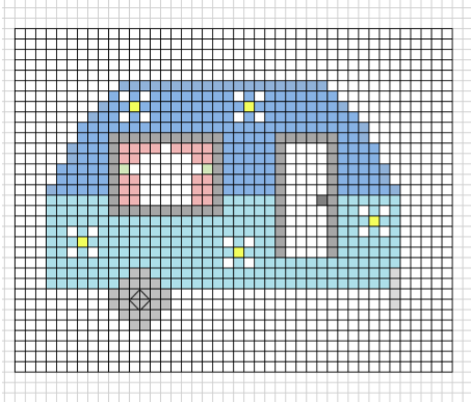

- Cross stitch graph paper 18 count printable pdf#
- Cross stitch graph paper 18 count printable portable#
- Cross stitch graph paper 18 count printable software#
- Cross stitch graph paper 18 count printable windows#

If you use a light blue pen like this and then stick the Solvy onto a light blue fabric, for example, you won’t be able to see the marks. Make sure that you test before hand to see if the pen you’re using to mark the design onto the Solvy will show, once the Solvy is stuck on your fabric. If you’re riding in a car, commuting on a train or bus, flying on an airplane, or sitting in a waiting room somewhere, you don’t need to refer to a chart while you’re stitching.
Cross stitch graph paper 18 count printable portable#
Pre-marking on the Solvy makes portable stitching super easy. Or, you can do what I did, and use a water-soluble marker (or something similar – don’t use a Sharpie!) to pre-mark the design, so that I didn’t have to refer to a chart while actually stitching. Then you just work your cross stitch on the grid, using the dots or the intersections on the grid as your stitch placement guide.
Cross stitch graph paper 18 count printable pdf#
I like to print a dotted grid (I’ve included a PDF printable for this particular dotted grid below), rather than a full-line grid, but you can do either. So, using Sticky Fabri-Solvy for cross stitch is not really much different from using it for surface embroidery, except that, instead of printing a design, you just print your grid. They do have some drawbacks – and you certainly wouldn’t use them on any kind of embroidery that you couldn’t wash! – but this type of printable, water-soluble stabilizer is terrific for projects on washable household items, like flour sack towels and the like. They supply an easy way to print a design and get it onto your fabric, to start stitching right away. Mostly, Transfer-Eze and Sticky Fabri-Solvy are used in the hand embroidery world for surface embroidery. It comes in printer-sized sheets (12 to a package), and it’s very easy to use.Īlthough I haven’t written an article devoted solely to Fabri-Solvy, I’ve written a tutorial and review about Transfer-eze, which came out before Fabri-Solvy, and which is exactly the same concept. It’s called Sticky Fabri-Solvy, and it’s a printable, stick-on, water-soluble stabilizer. It involves another product, and you might even have some on hand. A Third Option for Cross Stitching on Plain Weave Fabric Soluble canvas by DMC is a plastic sheet with evenly spaced holes in it, and you stitch into those holes. Waste canvas is a stiffish, open-weave fabric that you stitch over, and then you pull the threads of the canvas out from underneath your stitches. The first two options I mentioned were waste canvas and soluble canvas. There’s no grid on plain weave fabric, so you have to supply a grid, if you want decent looking cross stitches. Remember, plain weave fabric is any fabric that isn’t an even-weave fabric like the kind you’d normally use for counted work. In that article, we chatted about three ways that you can work cross stitch – or any counted technique, really – on plain weave fabric, but I didn’t clarify the third way you could do it, because I hadn’t finished my little stitchy projects to test it out.īut now I’ve finished them, so here we go!Īll three methods involve some sort of something that supplies a grid for the plain weave fabric. The company also provide a version for Windows, and even one for the iPad, so I can design wherever I am.On Monday, I shared with you a pattern for cross-stitched snowflakes of a folky sort, that can be used to embellish table linens, ornaments, and whatnot for the holiday season. This worked well and did just what I needed. Eventually I found MacStitch by Ursa Software.
Cross stitch graph paper 18 count printable software#
Cross stitch software for the MacĬross stitch software for the Mac was harder to find. I happily used Easy Cross for many years until moving from PCs to a Mac. Sadly the software I had chosen was slow to be updated, and eventually I started looking around for a replacement. I eventually settled on the most expensive program I could find, after all if it cost a lot it must be good eh?
Cross stitch graph paper 18 count printable windows#
The next step was a bigger and better computer (why is the one we have never good enough?) and I looked around for a Windows program.īy this time we also had the internet and I downloaded and tried all the cross stitch software I could find.

I soon learned that the benefits of designing cross stitch (and later blackwork) on the computer were many. No more scruffy hand-drawn charts with parts of the paper almost worn away where I had erased mistakes. It enabled me to print the charts that I sent to the magazine so they were neat and easy to read. Soon after that I discovered my first DOS cross stitch software. So what happened three weeks later? He would have had to chop off my hand to make me let go of the computer!


 0 kommentar(er)
0 kommentar(er)
